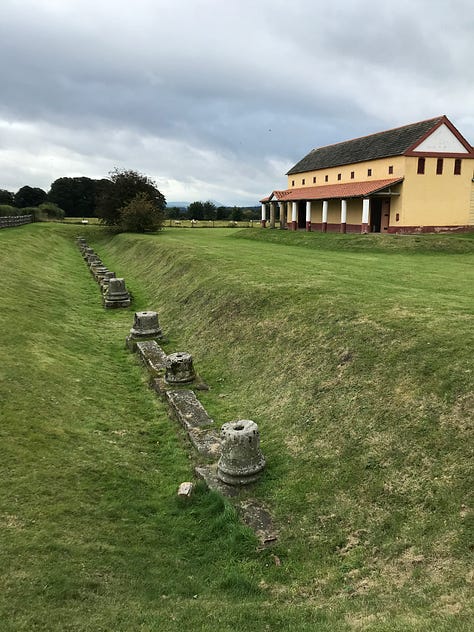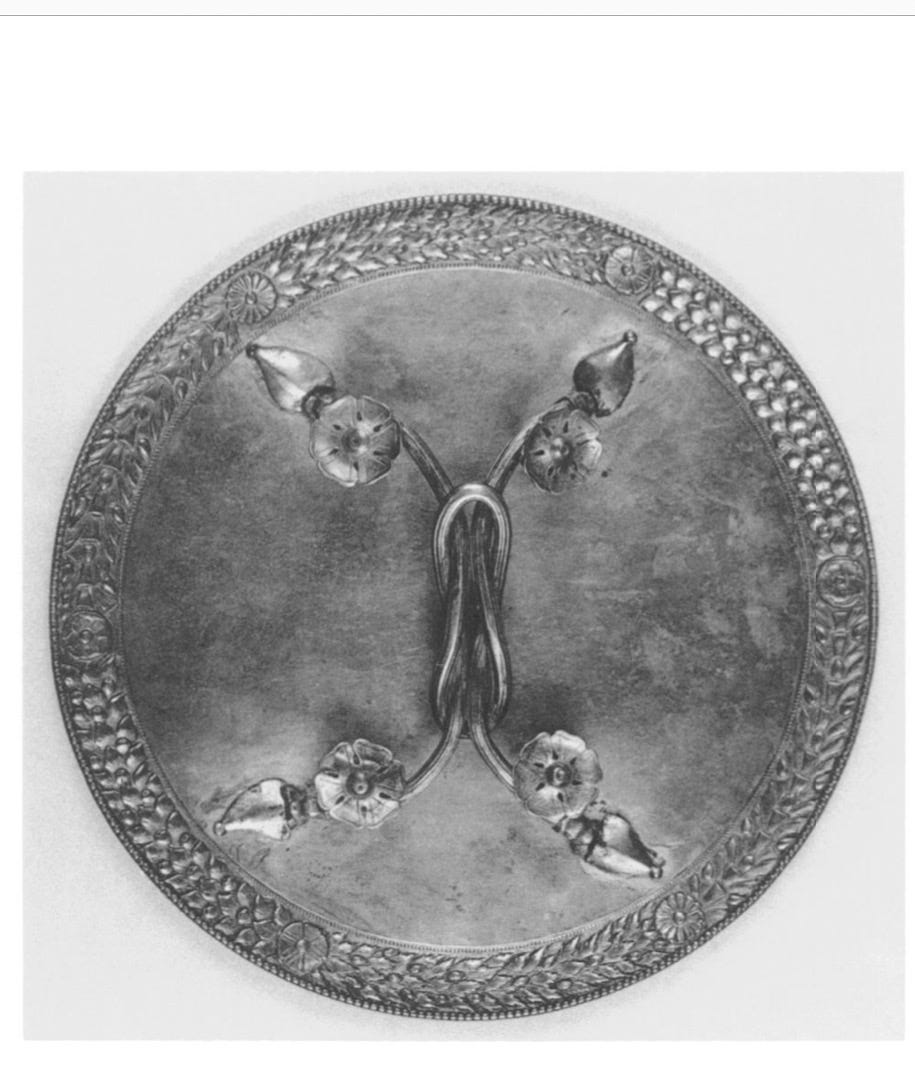{image author’s own]
Sometime in the eight, or maybe the ninth, century, an unknown Anglo-Saxon poet encountered the ruins of a Roman city in what was now England.
"…courtyard pavements were smashed; the work of giants is decaying. Roofs are fallen, ruinous towers, the frosty gate with frost on cement is ravaged…” he or she lamented, in the poem The Ruin of the Empire.
Scholarly opinions are divided as to exactly which ancient Romano-British city the poet describes. Suggestions include Chester and Bath, but surely nowhere better deserves the elegy than Wroxeter Roman city, (Viroconium Cornoviorum)? This was the capital of the Cornovii tribe, located a few miles from modern Shrewsbury in Shropshire.



[Images author’s own]
Of all the Roman sites revealed to date in Britain, Wroxeter can lay claim to being the most intriguing. And the most exasperating, in some ways. Yes, we have the mighty baths basilica wall left to us, together with the remnants of magnificent public baths, a fancy indoor market hall, clear evidence of a forum, even a reconstruction based on an actual Viroconian house. We know exactly where the walls surrounding this fourth-largest city of Roman Britain are. We understand the road layout. We can even locate the legionary fortress here, which once housed the XIV Gemina legion, followed by the XXth Valeria Victrix legion (until its permanent relocation to Chester).
[Image from Wroxeter Hinterland Project, by White & Gaffney]
We know all this due to the staggeringly comprehensive Wroxeter Hinterland archaeological project carried out by White, Gaffney and their colleagues from 1994, and reported in wonderful detail in 2013. Given the expanse of the city, and the funding available, they could not carry out any sizeable excavations. Instead they used geophysical survey, added to aerial photographs from 1950-1980s. The result is a detailed block-by-block account of the 78 hectare city, all 48 insulae of it.
Exasperating? Well yes, because apart from the well-known baths and market complex, and a select few other digs, very little has actually been excavated. Meaning what was revealed by the surveys is mostly the hidden outlines of buildings, streets and structures. A bit like covering up a table laden with exciting toys, and requiring children to discover what lies there only by feel.
There are some artefacts from these digs, and although there is a superb recently-extended museum on site at Wroxeter, I recommend you go to Shrewsbury Museum to find the best of what has been recovered. Meanwhile, this amazing treasure-house lies in open fields, awaiting decent funding and the archaeology manpower to make Wroxeter the Pompeii of Britain.
There you can see the famous Wroxeter silver mirror, one of very few found anywhere in the Roman world. It was designed to be held by a maid, so the (extremely wealthy) mistress could see her face in the polished convex side. The elaborate handle takes the form of a Herakles knot. It was found in the forum at Wroxeter in the 1920s, and at 29.2 cms diameter is one of largest ever found. It is evidence of the considerable luxury of Wroxeter.
If you’re wondering why I’m waxing so lyrical about Wroxeter, I have an announcement to make: drum roll!
I’ve agreed with my new publisher (hurrah!) to write a brand-new series, set in Wroxeter. The first book is well underway and will feature, of course, the gorgeous Wroxeter silver mirror. The mirror will go missing — linked to various mysterious deaths — and causing an unexpected new career for my Wroxeter hero, retired praefectus castrorum Otto Cornelius. We’ll still be in Severan period Roman Britain, just with a whole new cast of characters. (Actually, there will be one or two you might recognise, from my short story Wolves of Viroconium…)
If you’re a fan of my Quintus Valerius series, don’t worry! Quintus is going nowhere; just taking a short break for publishing rights reasons. He’ll be back soon in a new mystery (the Bath Curse story, already written and edited) and then more adventures, including, I hope, my recently researched Irish story.
I have further plans for Quintus beyond that: involving dead gladiators in London, maybe ructions in Spain. And Tiro’s romantic woes and martial arts displays will continue. So there’s lots more Roman Britain mystery reading to look forward to!
My January News
Apart from writing my new Otto Cornelius series, I’m beginning to plan my author talks and events for 2025. Here’s the latest:
The Ring, an anthology of thematically-linked stories by some of the most talented historical and contemporary fiction writers around, (plus me), is now in the final pre-publication stages. We’ve chosen to make the book a charity fund-raiser, with all proceeds going to a national library charity. More on this exciting project soon.
2 April: I’m guest speaker for the Evesham U3A, giving an illustrated talk about the research behind my books.
16 April: I’ll be heading west to speak to the Herefordshire Network.
May: I’m away, but not off the clock. We’re going to Pompeii and Herculaneum, a sort of busman’s holiday. I expect to be overwhelmed, and may not survive the excitement. There will be blogging…
In July, I’m attending the Theakston’s Old Peculiar Crime Writing Festival, at Harrogate. I’m told I’ll need to get into training for this intense weekend. As my hero Mick Herron is chairing the festival this year, my training mostly consists of thrilling myself with his entire Slow Horses series.
Fingers crossed Eboracum 2025 will be back in August this year, at York Museum. I hope to be there, in costume and with the first Otto Cornelius book to launch.
Jacquie’s latest Roman Britain mystery, The Loyal Centurion, is now out in ebook and paperback. You can find all her books, follow her on social media, watch her research videos, and read her magazine articles at Linktree.







When I worked at English Heritage in the early 1990s in the editors' room my colleague Margaret worked on 'Wroxeter' for the entire three years of my emplyment, barricaded behind a desk-cliff of books, mightily wroth with the finds reports, the reconstruction drawing captions, perpetually awaiting the fiddly soils and C14 and ceramics reports. It was a killer excavation monograph, but I don't think it did her in, I think she reached retirement.
So happy about the new books coming.
Which doesn't stop me being MADLY JEALOUS of you getting to go to Pompeii. You must bring back all possible photos for us. I've seen all the professional ones, but holiday snaps have a different charm to them, and a different emphasis.